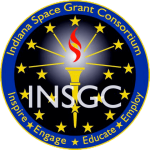NASA Mission Directorates
Starting in FY2020, the Indiana Space Grant Consortium (INSGC) and all NASA Office of STEM Engagement programs will increase efforts to highlight our programs' alignment with NASA Mission Directorates (MDs). All INSGC-funded projects are required to align with one or more NASA MDs. Please review the information below to find out more about all four NASA MDs before choosing which MD(s) and research priority area(s) your project most closely aligns with. For examples of research questions and projects within each MD, visit the websites listed below and review this NASA Mission Directorate pdf document.
Aeronautics Research Mission Directorate (ARMD): NASA’s aeronautics programs focus on six areas of research that develop solutions to the major challenges and opportunities for aviation: a growing demand for mobility, the sustainability of energy, the sustainability of the environment, and technology advances in information, communications and automation. ARMD conducts high-quality, cutting-edge research that generates innovative concepts, tools, and technologies to enable revolutionary advances in our Nation’s future aircraft, as well as in the airspace in which they will fly. ARMD programs will facilitate a safer, more environmentally friendly, and more efficient national air transportation system. Additional information on ARMD can be found at: http://www.aeronautics.nasa.gov
Research Priority Areas for ARMD:
- Safety, Efficiency, & Growth in Global Operations
- Innovation in Commercial Supersonic Aircraft
- Ultra-Efficient Commercial Vehicles
- Transition to Low-Carbon Propulsion
- In-Time System-Wide Safety Assurance
- Assured Autonomy for Aviation Transformation
- Advanced Air Vehicles
- Airspace Operations and Safety
- Integrated Aviation Systems
- Transformative Aeronautics Concepts
Human Exploration & Operations Mission Directorate (HEOMD): The Human Research Program (HRP) is focused on investigating and mitigating the highest risks to human health and performance in order to enable safe, reliable, and productive human space exploration. HEOMD focuses on studying/resolving health risks in order for humans to safely live and work on missions in and beyond low-Earth orbit. HRP conducts research, develops countermeasures, and undertakes technology development to address human health risks in space and ensure compliance with NASA's health, medical, human performance, and environmental standards. The International Space Station (ISS), currently orbiting the Earth with a crew of six, represents the NASA exploration activities in low-Earth orbit. Additional information on HEOMD can be found at: http://www.nasa.gov/directorates/heo/home/index.html
Research Priority Areas for HEOMD:
- Human Research
- Commercial Space Transportation
- Exploration Systems Development
- Human Space Flight Capabilities
- Advanced Exploration Systems
- Launch Services
- Space Transportation
- Space Communications
- Space Biology
- Space Life Science
- Physical Science Research
- Engineering Research
Science Mission Directorate (SMD): SMD uses the vantage point of space to achieve with the science community and our partners a deep scientific understanding of our planet, other planets and solar system bodies, the interplanetary environment, the Sun and its effects on the solar system, and the universe beyond. In so doing, we lay the intellectual foundation for the robotic and human expeditions of the future while meeting today's needs for scientific information to address national concerns, such as climate change and space weather. At every step we share the journey of scientific exploration with the public and partner with others to substantially improve science, technology, engineering and mathematics (STEM) education nationwide. Additional information on SMD can be found at: http://nasascience.nasa.gov
Research Priority Areas for SMD:
- Astrophysics
- Earth Science
- Heliophysics
- Planetary Science
- STEM Education & Communication
Space Technology Mission Directorate (STMD): STMD is responsible for developing the crosscutting, pioneering, new technologies, and capabilities needed by NASA to achieve its current and future missions. STMD rapidly develops, demonstrates, and infuses revolutionary, high-payoff technologies through transparent, collaborative partnerships, expanding the boundaries of the aerospace enterprise. By investing in bold, broadly applicable, disruptive technology that industry cannot tackle today, STMD seeks to mature the technology required for NASA’s future missions in science and exploration while proving the capabilities and lowering the cost for other government agencies and commercial space activities. Additional information on the Space Technology Mission Directorate (STMD) can be found at: http://www.nasa.gov/directorates/spacetech/about_us/index.html
Research Priority Areas for STMD:
- Transformative Crosscutting Technologies
- Technology Research & Development Challenges
- Advanced manufacturing methods for/in space
- Autonomous in-space assembly of structures/spacecraft
- Ultra-lightweight materials for space applications
- Materials and structures for extreme environments
- Extreme environment electronics for planetary exploration
- Advanced robotics for extreme environment testing
- Deep space optical communication
- Extremely High Frequency microwave technologies
- Advanced power generation, storage, and transfer for deep space missions
- Advanced entry, descent, and landing systems for planetary exploration
- Efficient in situ resource utilization for long-duration deep space missions
- Radiation mitigation for deep space crewed missions
- Biological approaches to environmental control and life support systems
- Autonomous systems for deep space missions
- Advanced telescope technologies for exoplanet imaging
- Low size, weight, and power components for small spacecraft
- Advancements in engineering tools and models supporting STMD

